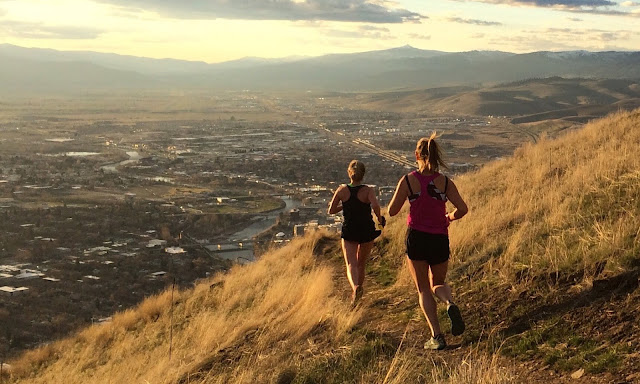 |
| Dakota Umbel and Sophie Tsairis on Mount Sentinel above Missoula. Photo: Kristina Pattison |
Working our way up Northwest Ridge route, our conversation fizzles. Breaths are saved for breathing. We settle into a grind, pushing down on our knees and navigating over and through the occasional stair-stepping rocks, grabbing here and there for balance. After the final push to the top, I turn to see beaming faces. Some looks of relief mixed with accomplishment but all smiling, all proud, all women.
This is Missoula and the women here run.
But when I moved to Missoula I was not a runner. During 2009, I was a rookie candidate for the Missoula Smokejumpers. Among a class of eight that dwindled to five, I was the last standing female among a group of outstanding males. It was not easy, but it was a common theme in my life. Smokejumping taught me many lessons about what women are, what we can be, and why we consistently do or do not achieve our aspirations.
Women can be surprisingly stubborn. For good or for bad, we tend to stick to our guns.
Approximately 20% of wildland firefighters in America are female. That number drops to about 10% of the nearly 400 smokejumpers employed in America to parachute into mountainous terrain to extinguish wildland fires in remote areas. When I graduated the program, six of 80 active jumpers working at the Missoula Smokejumper Base were female. All strong, all stubbornly independent, all of us six: women.
While working for the smokejumpers, and finishing my undergraduate education at the University of Montana Health and Human Performance Department, I had the opportunity to assist Joseph Domitrovich, PhD, and Steven Gaskill, PhD, at the Human Performance Lab. During their research studies for the USFS Missoula Technology & Development Center, we learned the relative fitness of female smokejumpers is significantly higher than male smokejumpers.
Relative fitness is a ratio of the aerobic threshold of an athlete divided by their maximum aerobic capacity. Basically, it suggests the percentage of a person’s max output they will be able to sustain while exercising. In real terms, this means women smokejumpers work at a much higher percent of their aerobic max capacity than men.
But why? The men are still bigger, and often have higher maximum aerobic capacity. But the men aren’t using all of their engine. Performing daily work like cutting fire line with hand tools, using chainsaws, or carrying heavy packs is not maxing the gears in the men. The women are trained to use more of their engine effectively, to perform the same grueling 16-hour shifts of arduous manual labor in extreme environments as their male counterparts.
So how does a woman get to be so physically tough? Anecdotally I can say: mental grit.
Women smokejumpers invariably train throughout the winter, obsessively lifting, hiking, eating, running, skiing, etc. to maintain their extraordinarily high levels of fitness. The aerobic threshold of women smokejumpers when tested was comparable to the most elite female athletes in the world. Male smokejumpers, when cross-compared with the general population at different age groups out-perform at every age. They too are considered among some of the fittest men in America, so they set a high standard for the women to match.
It takes a particularly tough and confident mental constitution for any female candidate to attempt that lofty goal. Of course some physical characteristics are preferable, but as one of the smallest women ever to jump, I can say truthfully 99.9% of the battle is mental grit.
Some women will try, some women will succeed, most women will not. I have spent every year since 2009 mentoring both. What is the difference between those who try and those who succeed?
Those who succeed believe they can and they chose the path to get there. When it gets hard, they stop talking and they keep walking.
Since 2014, I have been on the board of Montana Trail Crew, a non-profit organization advertised at that time as being committed to “building a trail running community in Montana…” along with being a resource for education and stewardship for the preservation and maintenance of our local trail system. During the summer of 2014, I started a women’s trail running group through MTC in Missoula to facilitate an environment that would encourage women to run together and build each other up.
Suffering under a common purpose brings people together on a deeper level that cannot be achieved in any other way.
People with a common purpose share a collective conscience. We share trails, we value trails, we value each other, and we take care of all of the above.
More often than not, I am approached by women who will not run with me. They tell me they cannot run with me. I tell them they can. They tell me they can’t.
I’m telling you: you can.
We meet Fridays, 6:30pm at the M trailhead parking lot. Tell yourself you can.
 runwildmissoula.org >>
runwildmissoula.org >>